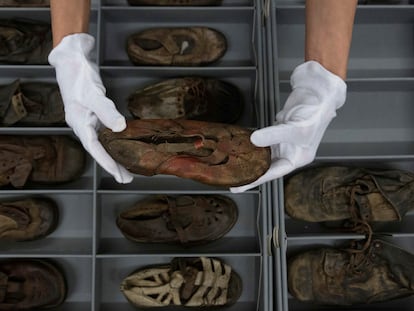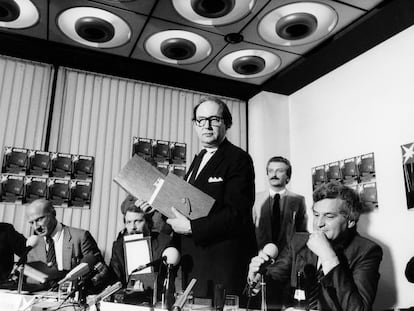First train to Auschwitz: Newly discovered photographs believed to show earliest Polish deportation
A collector has donated a series of images showing the arrival of a convoy of prisoners that inaugurated transfers to the concentration camp in June 1940
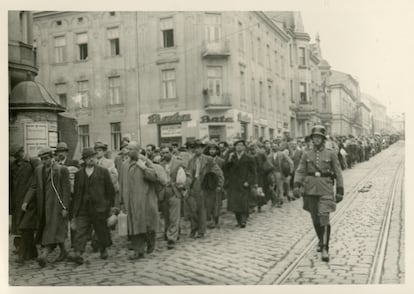
Photographs dating from June 1940 have recently been discovered, among them one showing a long line of people walking through the main streets of the Polish town of Tarnów, near Kraków. They are seen leaving the bathhouse, passing by small stores, and walking up a ramp to a waiting train. Their destination, unannounced, was Auschwitz. The images, found by a collector and donated to the museum at the former concentration camp, are believed to show the first deportation in history to what would become the enduring symbol of Nazi infamy. In the hands of totalitarian power, the image became a lethal instrument. Propaganda, one of the key elements in the rise of the Nazi Party, was elevated by the political police to a new visual category of terror. As the Third Reich took hold and Heinrich Himmler, the all-powerful Minister of the Interior, connected all the forces of law and order and placed them under his control, graphic reportage was incorporated into his working methodology.
The images narrate the crucial moment for which those shock forces had been created: deportation to the concentration camps. They were the control group, a test sample of a program that would be repeated hundreds of times. Proud, smiling, the cadres of the occupation police posed and showed their security colleagues how they were to carry out the operation. Punishment manuals, the photographic albums of the various branches of the SS, followed a strict protocol of brutality. They were the essence of deportation, the handing over of prisoners from one chain to another, all the way to the camps. Very few of these reports were preserved after the war, reduced to inspection visits to the camps, to high society, and to the Nazi hierarchy itself.
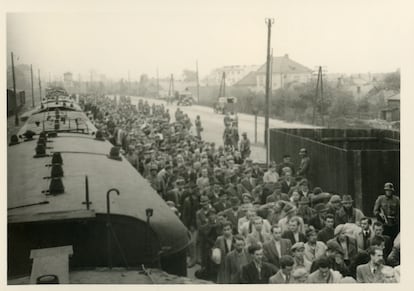
The discovery of one of these albums is always important, but if it is the first deportation convoy to Auschwitz, it has undoubtedly historical significance. Its discoverer, Marek Tomaszewski, the first to identify it, downloaded it digitized in an email from a collector in Canada, as he explains in his recent book Tarnów-KL Auschwitz: The First Transport to Hell. The album contained 96 excellent-quality images that he decided to donate to the Auschwitz Memorial Archive and Museum for preservation. There they continue to study in depth a material of great importance for European history.
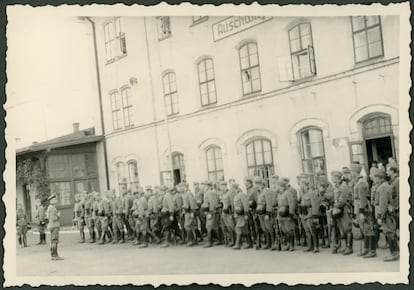
Major discoveries serve to confirm what we already know, what we were already looking for. Other smaller discoveries, which seem casual and often go unnoticed, can end up changing our vision of the past. These images mark a point of no return in the expansion of the German concentration camp program: 83 years ago, on June 14, 1940, the first transport of Polish prisoners left for Auschwitz. At that time, it was nothing more than a former prison that the Nazis had incorporated into their network of labor and concentration camps — Konzentrationslager, or KL — long before it was turned into the most infamous extermination center of the war.
Behind those orderly rows of prisoners was a lot of groundwork. The beginning of the Nazi occupation, the partition of the country with the Soviets, the establishment of a new administrative demarcation called the General Government and, above all, the use of information and of seized documentation. Population censuses, files, and photographic records themselves served to draw up lists that of people who were filling the camps all over the map of the new German order. On this one there were students, soldiers, teachers, workers, doctors, lawyers, priests and professional athletes. All of them were men, accused of belonging to organizations opposed to the new government: opposed, in short, to the German occupation. They were placed in protective custody, a legal measure that had already been used in Austria and Czechoslovakia, by which they passed from the Army into the hands of the Gestapo.
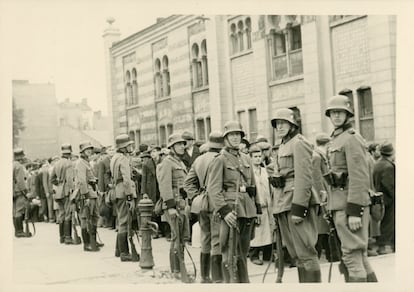
These photos immortalize that transfer, images that have never before been seen among the millions of documents collected by the Allies as evidence of Nazi crimes. They are all that remains of their last contact with life, as they knew it until then. Ordinary people, classified and deported as political prisoners to an SS concentration camp. But at the time, they were unaware of this. Puzzled by the strange helmets of the guards, some of them looking directly at the camera, they clutched their hats and placed their hands in their coats, pretending to be in a hurry. They were carrying suitcases: they had been ordered to pack for a trip. There were no Jews among them, or at least not in the front rows, where the 10 cm star Jewish people were obliged to wear is not visible. The records provide the full picture. Of the 728 Poles who were transported in that convoy, 292 were killed, among them 11 Jews: 325 survived and 111 are still listed as missing.
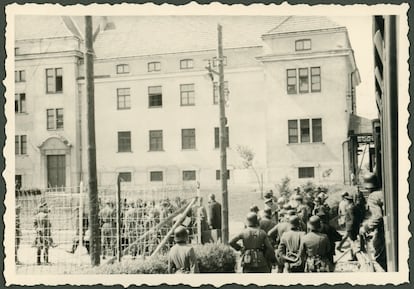
The line advances along Tarnów’s main street. The photographer also captures the German commanding officer. He sets the pace of the procession and is unarmed, walking alongside the prisoners. He doesn’t see them; he just follows the streetcar rails, knowing that they will end up on the trains. From the heart of medieval cities to the camps themselves, the logistics devised by Adolf Eichmann connected the German war machine through a system of industrial exploitation based on forced labor and the destruction of lives. The journey was not a long one.
They walked down to the platform in rows of four until they reached the old prison on foot. A sign in German gothic script announced their arrival at a place none of them had heard of: Auschwitz. A full battalion of guards was waiting for them at the entrance. Some shook their heads, eager to receive a human commodity they knew to be inexhaustible. In just five days, another Polish convoy would arrive. As the war dragged on and their task turned to the Final Solution, the photographs, evidence of their involvement in deportations or at the camps, disappeared. But some remained, hidden, to be found decades later.
Sign up for our weekly newsletter to get more English-language news coverage from EL PAÍS USA Edition
Tu suscripción se está usando en otro dispositivo
¿Quieres añadir otro usuario a tu suscripción?
Si continúas leyendo en este dispositivo, no se podrá leer en el otro.
FlechaTu suscripción se está usando en otro dispositivo y solo puedes acceder a EL PAÍS desde un dispositivo a la vez.
Si quieres compartir tu cuenta, cambia tu suscripción a la modalidad Premium, así podrás añadir otro usuario. Cada uno accederá con su propia cuenta de email, lo que os permitirá personalizar vuestra experiencia en EL PAÍS.
¿Tienes una suscripción de empresa? Accede aquí para contratar más cuentas.
En el caso de no saber quién está usando tu cuenta, te recomendamos cambiar tu contraseña aquí.
Si decides continuar compartiendo tu cuenta, este mensaje se mostrará en tu dispositivo y en el de la otra persona que está usando tu cuenta de forma indefinida, afectando a tu experiencia de lectura. Puedes consultar aquí los términos y condiciones de la suscripción digital.
More information
Archived In
Últimas noticias
Most viewed
- Oona Chaplin: ‘I told James Cameron that I was living in a treehouse and starting a permaculture project with a friend’
- Reinhard Genzel, Nobel laureate in physics: ‘One-minute videos will never give you the truth’
- Sinaloa Cartel war is taking its toll on Los Chapitos
- Why the price of coffee has skyrocketed: from Brazilian plantations to specialty coffee houses
- Silver prices are going crazy: This is what’s fueling the rally
